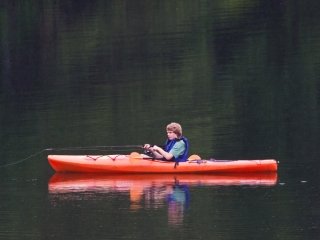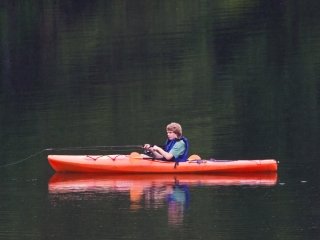 My series on fishing from watercraft without an engine draws to an end with a great article highlighting the advantages and disadvantages of fishing from kayak. Commonly thought of as mainly a means of exercise or sightseeing on the water, due to their requirement of skill and concentration to use, kayaks are actually popular methods of transportation for fishermen, especially for inshore anglers. Again, I personally would never fish from a kayak in an area with large predators, such as sharks or alligators, and would never advise anyone else to, for that matter, but many anglers find great success fishing from these one-man vessels.
My series on fishing from watercraft without an engine draws to an end with a great article highlighting the advantages and disadvantages of fishing from kayak. Commonly thought of as mainly a means of exercise or sightseeing on the water, due to their requirement of skill and concentration to use, kayaks are actually popular methods of transportation for fishermen, especially for inshore anglers. Again, I personally would never fish from a kayak in an area with large predators, such as sharks or alligators, and would never advise anyone else to, for that matter, but many anglers find great success fishing from these one-man vessels.
Kayaks do take a little more practice getting used to than canoes, due to their smaller and slimmer design, but learning to skillfully navigate rivers and lakes with these crafts isn’t as daunting as it may seem. Simply keep your balance and, if needed, learn how to execute an Eskimo roll, should you ever flip the kayak, and you’ll be fine. Fishing from one takes a little more practice, as it requires less strength and movement, and more finesse and steadiness. Learn to mainly utilize your arms when fishing from a kayak, and resist the urge to lean, especially when setting the hook.
A nice feature of kayaks is their small size, and how it allows you to go anywhere on the water. This also enables you to transport them without having to own a truck or SUV, since you can buy a rack for even a small sedan to transport your kayak. Also, should you come to a break in a river, or want to take a break, you can easily carry a kayak and move around an obstacle or pull it onto shore should the need arise.
There are some drawbacks to kayaks, however. First and foremost, the small size that is very versatile is also a hindrance when it comes to storing gear and tackle. Kayaks usually only come equipped with one or two small storage compartments, so you’ll need to limit what you bring with you to just the essentials. Of course, you can always purchase a fishing vest, which is equipped with several pockets and compartments for specific gear, to add more storage capacity. Keeping your fishing rod out of the way, while still keeping the ore handy will get a little tricky, as well, but I suggest investing in a kayak that is equipped with nylon straps at either ends, which will help solve this problem.
Overall, fishing without a boat with an engine can be more work, but the exercise, the peace and quiet, and the excitement of meandering through rivers and lakes without the roar of an engine, the aid of a sonar, or trolling motor will be more rewarding at the end of the day. Experiencing fishing the way it was done hundreds of years ago is a great feeling that any angler can appreciate, and is one that, from experience, you’ll never forget. I have some great photos of my canoeing excursions with my uncle down in the bayous of Louisiana that highlight some of my fondest memories of fishing and being immersed in untouched nature. In my opinion, you really can’t fully enjoy fishing and the outdoors until you’ve gotten as close as you can to nature, and fishing from a kayak, canoe, or float tube does just that.








